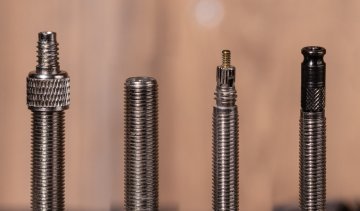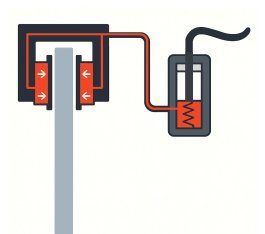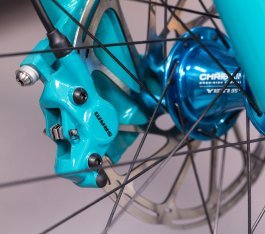
Bicycle Valves – Types, Differences & Comparison
Our guide explains the main bicycle valve types and their differences – from classic Presta to the innovative Schwalbe Clik Valve.
Disc brakes are now standard on most bikes and e-bikes. Here’s how to decide whether a 2- or 4-piston brake is right for you.
Disc brakes are the most effective way to bring your bike to a stop. Originally developed for mountain bikes, they have now found their way into every discipline, including road bikes. Today, hydraulic disc brakes are the dominant standard. Within this system, there are two main designs: two-piston and four-piston brakes. We explain the differences and help you understand which one is right for you.

Brake fluid is pushed from a master cylinder into the caliper and moves the pistons toward the brake rotor. © bc GmbH
Before we dive deeper, a quick overview: when we talk casually about pistons here, we mean the slave pistons in a fluid-filled system – technically referred to as hydraulic. These slave pistons are only one part of the entire braking system. You pull the brake lever of your disc brake. The master piston in the lever pushes brake fluid through the hose towards the brake calliper and presses onto the slave pistons. The slave pistons then push the brake pads against the rotor: Voilà! Friction, braking, stopping.
The master cylinder sits at the brake lever and, using hand force, pushes the brake fluid through the hose toward the caliper. © bc GmbH
The system described above works in its simplest form with two slave pistons in the brake calliper — one on each side of the brake rotor. Because only a few components are involved, complexity, weight and often also the price are reduced. With two pistons, it’s also easier to ensure that both move evenly. However, the design has limits. Maximum braking power increases when more pad surface can press onto the rotor. The diameter of the pistons can’t be increased endlessly — and that’s where four-piston brakes come into play.
Not every manufacturer makes it as easy to count the brake pistons from the outside as Magura does. © bc GmbH

Two-piston brakes have two opposing pistons that press on the brake rotor from both sides. Shown here: a SRAM Level. © bc GmbH
With a four-piston brake, two pistons on each side press the brake pads against the brake rotor — so, four in total! This allows for a larger effective pad contact area and provides a high and evenly distributed pressure of the pads on the rotor. The result: more maximum braking power, better modulation, improved heat dissipation and therefore lower risk of performance loss due to overheating (known as fading), plus more even pad wear.
So why not always choose four pistons? More components mean more complexity and more weight — and not every riding situation requires maximum braking power.
On Shimano brakes, the pistons are made of ceramic — which is why they are easy to spot here in the XT MTB brake caliper. © bc GmbH

4-piston brakes are used whenever maximum braking performance matters more than saving 15 grams of weight. © bc GmbH
From high-end road bikes to children's bikes: 2-piston brakes offer an unbeatable balance of weight and braking power. © bc GmbH
The two-piston brake is ideal wherever:
You’ll typically find them on cross-country and marathon mountain bikes, gravel bikes, road bikes, urban and city bikes, as well as lighter e-bikes designed for everyday use in flatter terrain — or simply if the rider themself is lighter.
Demonstration model: This Trickstuff brake with a transparent housing shows the pistons and where air bubbles can still hide. © bc GmbH
The four-piston brake shines wherever:
That’s why four-piston brakes are common in trail and gravity mountain biking, on e-mountain bikes of all travel categories, on heavy SUV and touring e-bikes with high load capacity, and on cargo bikes. Four-piston brakes are also the right choice if you simply want more stopping power.
Some brands, such as Magura, also offer brake setups that combine powerful four pistons at the front with lighter two pistons at the rear.
Whether two- or four-piston brakes: beyond upgrading the brake itself, you have several ways to increase braking power or reduce heat sensitivity:
Increase braking power with larger rotors, different pad compounds or stiffer brake hoses. © bc GmbH
You might ask yourself: if four pistons offer more power than two, wouldn’t six pistons be even better? The answer (at least for now) is: no – not on a bike! Because until the industry surprises us with truly new materials, the rule is: to press six pistons onto the rotor with enough force, everything else in the brake system would also have to grow. Lever ratios, reservoir sizes, oil or DOT volume, and of course the pads themselves. The result would be a very heavy brake that is expensive and takes up more space. The disadvantages would outweigh the benefits.
In fact, even forks and frames would have to be made stiffer to cope with the additional braking forces. But this is power you likely wouldn’t be able to transfer to the ground anyway through your relatively narrow bicycle tires — and which is generally unnecessary at the comparatively lower speeds and system weights of bicycles. For now, six-piston brakes haven’t progressed beyond prototypes and April Fool's jokes. They remain the domain of motorcycles and cars. Two or four pistons remain the sweet spot in the bike world.
With a 2-piston brake, two pistons – one on each side – push the brake pads against the rotating rotor. A 4-piston brake uses four pistons, applying the pads over a larger contact area. More pistons mean greater braking power, better modulation and heat management – but also slightly more weight and complexity.
It depends on your riding style. 2-piston brakes are lighter, cheaper and ideal for cross-country, gravel or city bikes. 4-piston brakes deliver more power and control on long descents or heavier bikes – perfect for trail, enduro, downhill and e-MTBs and SUV e-bikes.
If you ride steep descents, carry luggage or ride a heavier bike, 4-piston brakes are worthwhile. They offer more thermal stability and reduce the risk of brake fade.
Yes, slightly. They use larger calipers and more components. The weight increase is usually only a few dozen grams and is negligible considering the performance gain.
Yes. Many brands – such as Magura – combine a strong 4-piston brake up front with a lighter 2-piston brake in the rear. This saves weight and matches real braking dynamics: most braking force goes through the front wheel.
For heavy e-MTBs or SUV-style e-bikes, choose 4-piston brakes. For lighter city e-bikes, 2 pistons are often sufficient.
Use larger rotors (check max size allowed by your frame and fork), choose sintered pads, upgrade to steel-braided brake lines, and maintain your brakes regularly (clean rotors, bed in pads properly).
Overheating causes brake fade – loss of braking performance. 4-piston brakes dissipate heat better due to larger surface contact.
In theory yes, in practice no. 6-piston brakes would be heavier, bulkier and unnecessary for bicycles. 2 or 4 pistons are the optimal balance.
If the lever feels spongy, the brakes squeal, rub or lose power – service is due. Air in the system or contaminated pads are common causes.
No. Bicycle brakes are friction brakes that convert kinetic energy into heat. Regenerative braking requires additional heavy components and is not used on normal bikes.